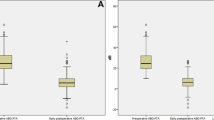Abstract
The aim of this study is to determine differences in postoperative air–bone gap (ABG) after placement of teflon–platinum or nitinol middle ear prostheses in primary stapedotomy patients with otosclerosis. Thirty otosclerosis patients (24 female, 6 male; age 10–61 years) with primary stapedotomy were studied prospectively. Before and after surgery, the mean and standard deviations of the ABG were measured at eight frequencies (0.25–4 kHz). Patients were randomized into one of two groups receiving either teflon–platinum or nitinol prostheses. Hearing results were assessed 1 year after surgery. To assess the joint influence of treatment and frequency on ABG reduction, a linear mixed model was used (significance level was p = 5 %). The Tukey–Kramer method was used to adjust for multiple comparisons. Significant differences were found between treatment groups (p < 0.0001) and between frequencies within the same treatment group (p < 0.0001) but no interaction (p = 0.7963), i.e. the reduction of the conductive components over frequencies was nearly parallel in both groups. Overall, patients in the Teflon group had a larger reduction of conductive components, on average 8.0 dB more reduction, than patients in the nitinol group. However, after adjusting for multiple comparisons, we could not identify a single frequency with a significant difference in reduction of conductive components. Use of the teflon–platinum prosthesis results in statistically non-significant better ABG closure at 0.25–4 kHz 1 year postoperatively than the use of the nitinol prosthesis.



Similar content being viewed by others
References
Shea JJ Jr (1958) Fenestration of the oval window. Ann Otol Rhinol Laryngol 67:932–951
Rajan GP, Diaz J, Blackham R, Eikelboom RH, Atlas MD, Shelton C, Huber AM (2007) Eliminating the limitations of manual crimping in stapes surgery: mid-term results of 90 patients in the Nitinol stapes piston multicenter trial. Laryngoscope 117:1236–1239
Babighian G, Fontana M, Caltran S, Ciccolella M, Amadori M, De Zen M (2007) The heatactivated stapes prosthesis ‘SMart’ Piston: technique and preliminary results. Adv Otorhinolaryngol 65:190–196
Rajan GP, Atlas MD, Subramaniam K, Eikelboom RH (2005) Eliminating the limitations of manual crimping in stapes surgery? A preliminary trial with the shape memory Nitinol stapes piston. Laryngoscope 115:366–369
Gerlinger I, Tóth M, Bakó P, Németh A, Pytel J (2008) KTP-laser stapedotomy with a self-crimping, thermal shape memory nitinol smart piston: 1 year follow up results: how we do it. Clin Otolaryngol 33:472–480
Pudel EI, Briggs RJS (2008) Laser-assisted stapedotomy with a nitinol heat-crimping prosthesis: outcomes compared with a platinum fluoroplastic prosthesis. Otolaryngol Head Neck Surg 139:51–54
Fisch U (2008) Stapedotomy and stapedectomy in tympanoplasty, mastoidectomy and stapes surgery, 2nd edn. Thieme, Stuttgart, New York, pp 222–238
Hüttenbrink KB (2003) Biomechanics of stapesplasty: a review. Otol Neurotol 24:548–559
Mann W, Beck Chl (1983) Functional results after stapesplasty (Funktionelle Ergebnisse nach Stapesplastik). Laryng Rhinol Otol 62:387–390 in german
Gerard JM, Serry P, Gersdorff MC (2008) Outcome and lack of prognostic factors in stapes surgery. Otol Neurotol 29:290–294
Huber AM, Veragut D, Schmid S, Roth T, Eiber A (2008) Tight stapes prosthesis fixation leads to better functional results in otosclerosis surgery. Otol Neurotol 29:893–899
Monsell EM, Balkany TA, Gates GA, Goldenberg RA, Meyerhoff WL, House JW (1995) Committee on Hearingg and Equilibrium guidelines for the evaluation of results of treatment of conductive hearing loss. Otolaryngol Head Neck Surg 113:186–187
Brown KD, Gantz BJ (2007) Hearing results after stapedotomy with a nitinol piston prosthesis. Arch Otolaryngol Head Neck Surg 133:758–762
Harris JP, Gong S (2007) Comparison of hearing results of nitinol smart stapes piston prosthesis with conventional piston prostheses: postoperative results of nitinol stapes prosthesis. Otol Neurotol 28:692–695
Van Rompaey V, Claes G, Potvin J, Wouters K, Van de Heyning PH (2011) Systematic review of the literature on nitinol prostheses in surgery for otosclerosis: assessment of the adequacy of statistical power. Otol Neurotol 32(3):357–366
Author information
Authors and Affiliations
Corresponding author
Rights and permissions
About this article
Cite this article
Gouveris, H., Tóth, M., Koutsimpelas, D. et al. Short-term hearing results after primary stapedotomy with nitinol and teflon–platinum prostheses for otosclerosis. Eur Arch Otorhinolaryngol 270, 2201–2205 (2013). https://doi.org/10.1007/s00405-012-2262-6
Received:
Accepted:
Published:
Issue Date:
DOI: https://doi.org/10.1007/s00405-012-2262-6




